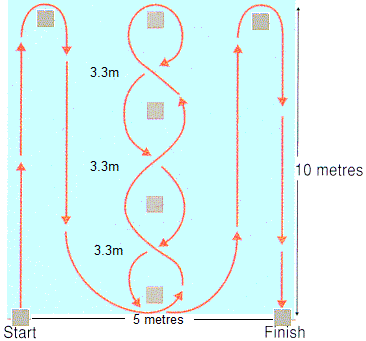

Illinois Agility Run Test
Testing and measurement are the means of collecting information upon which subsequent performance evaluations and decisions are made. In the analysis, we need to consider the factors influencing the results.
Objective
The Illinois Agility Run Test (Getchell 1979)[2] monitors the athlete's agility development.
Required Resources
To conduct this test, you will require:
- Flat non-slip surface.
- Eight cones.
- Stopwatch.
- Assistant.
How to conduct the test
This test requires the athlete to run the red line route in the diagram below as fast as possible.

- The athlete warms up for 10 minutes.
- The assistant sets up the course as detailed in the diagram.
- The athlete lies face down on the floor at the “Start” cone.
- The assistant gives the command “GO” and starts the stopwatch.
- The athlete jumps to their feet and negotiates the course around the cones following the red line route as shown in the diagram to the finish.
- The assistant stops the stopwatch and records the time when the athlete passes the “Finish” cone.
Analysis
The test result is analysed by comparing it with the athlete's previous results for this test. It is expected that the analysis would indicate an improvement in the athlete's agility and speed with appropriate training between each test.
Target Group
This test is suitable for team sports but not for individuals where the test would be contraindicated.
Reliability
Test reliability refers to how a test is consistent and stable in measuring its intended measure. Reliability will depend upon how strictly the test is conducted and the individual's level of motivation to perform the test. The following link provides various factors influencing the results and test reliability.
Validity
Test validity refers to the degree to which the test measures what it claims to measure and the extent to which inferences, conclusions, and decisions based on test scores are appropriate and meaningful. This test provides a means to monitor training on the athlete's physical development.
Advantages
- Minimal equipment is required.
- Simple to set up and conduct.
- The athlete can administer the test.
- It can be conducted almost anywhere.
Disadvantages
- An assistant is required to administer the test.
References
- DAVIS, B. et al. (2000) Physical Education and the study of sport. 4th ed. London: Harcourt Publishers. p.129
- GETCHELL, G. (1979) Physical Fitness a way of life, 2nd ed. New Jersey, John Wiley and Sons
Page Reference
If you quote information from this page in your work, then the reference for this page is:
- MACKENZIE, B. (2000) Illinois Agility Run Test [WWW] Available from: https://www.brianmac.co.uk/illinois.htm [Accessed